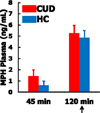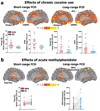Effects of chronic and acute stimulants on brain functional connectivity hubs
- PMID: 25721787
- PMCID: PMC4547912
- DOI: 10.1016/j.brainres.2015.02.002
Effects of chronic and acute stimulants on brain functional connectivity hubs
Abstract
The spatial distribution and strength of information processing 'hubs' are essential features of the brain׳s network topology, and may thus be particularly susceptible to neuropsychiatric disease. Despite growing evidence that drug addiction alters functioning and connectivity of discrete brain regions, little is known about whether chronic drug use is associated with abnormalities in this network-level organization, and if such abnormalities could be targeted for intervention. We used functional connectivity density (FCD) mapping to evaluate how chronic and acute stimulants affect brain hubs (i.e., regions with many short-range or long-range functional connections). Nineteen individuals with cocaine use disorders (CUD) and 15 healthy controls completed resting-state fMRI scans following a randomly assigned dose of methylphenidate (MPH; 20mg) or placebo. Short-range and long-range FCD maps were computed for each participant and medication condition. CUD participants had increased short-range and long-range FCD in the ventromedial prefrontal cortex, posterior cingulate/precuneus, and putamen/amygdala, which in areas of the default mode network correlated with years of use. Across participants, MPH decreased short-range FCD in the thalamus/putamen, and decreased long-range FCD in the supplementary motor area and postcentral gyrus. Increased density of short-range and long-range functional connections to default mode hubs in CUD suggests an overrepresentation of these resource-expensive hubs. While the effects of MPH on FCD were only partly overlapping with those of CUD, MPH-induced reduction in the density of short-range connections to the putamen/thalamus, a network of core relevance to habit formation and addiction, suggests that some FCD abnormalities could be targeted for intervention.
Keywords: Addiction; Brain hubs; Cocaine; Dopamine; Functional magnetic resonance imaging; Methylphenidate; Resting-state connectivity.
Copyright © 2015 Elsevier B.V. All rights reserved.
Conflict of interest statement
No conflicts declared.
Figures




References
-
- Belin D, Everitt BJ. Cocaine seeking habits depend upon dopamine-dependent serial connectivity linking the ventral with the dorsal striatum. Neuron. 2008;57:432–441. - PubMed
-
- Buckner RL, Andrews-Hanna JR, Schacter DL. The brain's default network: anatomy, function, and relevance to disease. Ann N Y Acad Sci. 2008;1124:1–38. - PubMed
-
- Cole DM, Beckmann CF, Long CJ, Matthews PM, Durcan MJ, Beaver JD. Nicotine replacement in abstinent smokers improves cognitive withdrawal symptoms with modulation of resting brain network dynamics. Neuroimage. 2010a;52:590–599. - PubMed
Publication types
MeSH terms
Substances
Grants and funding
LinkOut - more resources
Full Text Sources
Other Literature Sources
Medical

